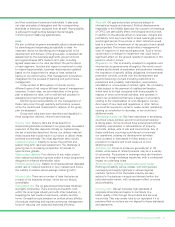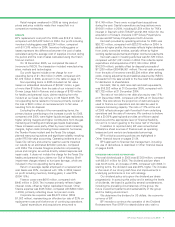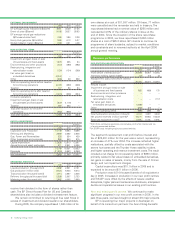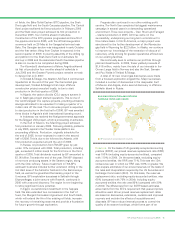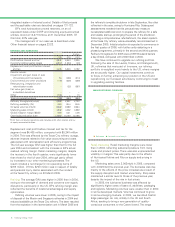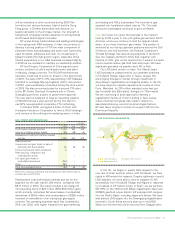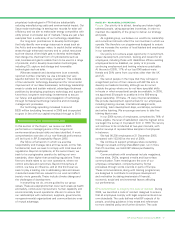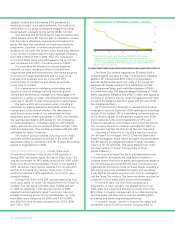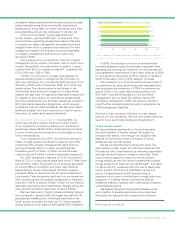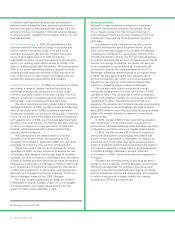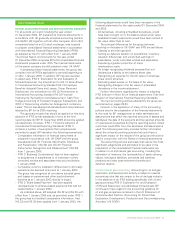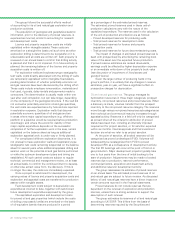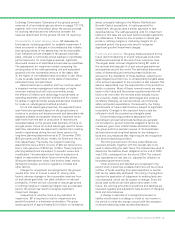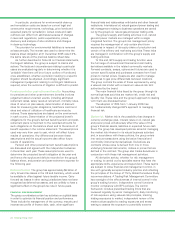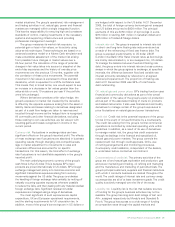BP 2005 Annual Report Download - page 21
Download and view the complete annual report
Please find page 21 of the 2005 BP annual report below. You can navigate through the pages in the report by either clicking on the pages listed below, or by using the keyword search tool below to find specific information within the annual report.
BP Annual Report and Accounts 2005 19
In 2005, we developed a new set of environmental
principles designed to give us a consistent approach when
assessing and entering new locations. The new process will
be progressively implemented in new major projects. In 2005,
no new decisions were taken by BP to explore or develop in
World Conservation Union (IUCN) category I-IV areas.
We constantly try to limit the environmental impact of
our operations by using natural resources responsibly and
reducing waste and emissions. In 2004, we achieved our
goal of 100% of our major sites being certified to the
ISO 14001 international standard on environmental
management, but our Texas City refinery had its ISO
certification suspended in 2005. The refinery intends to
recertify after completing planned work to strengthen its
HSSE management systems.
We seek to have a positive influence on major issues
beyond our own operations. The two main areas where we
seek to do so are climate change and development.
BP AND CLIMATE CHANGE
BP has contributed significantly to the evolving public
and policy debate on climate change. We support a
precautionary stance, even though we recognize that
aspects of the science remain the subject of expert
debate and are not fully proved.
We also accept that this is a long-term issue. The
goal must be to take urgent but informed measures that
will stabilize GHG concentrations by delivering sustainable
and cost-efficient long-term emission reductions. Fossil
fuels currently supply the majority of all the primary
energy people use and will remain fundamental to global
energy supply for at least the next 20-30 yearsa. Innovation
to reduce the CO2emissions from the use of fossil fuels
will be a major contributor to stabilization during this
period. Companies such as BP therefore have an
important role to play in contributing to energy policy and
education, in enabling market mechanisms such as
emissions trading to operate and in developing innovative
technological solutions.
We believe that governments and businesses must
work together to develop appropriate policy responses.
We support an approach that recognizes the existence
DIRECT GHG EMISSIONS (million tonnes CO a
2 equivalent)
05 78.0
04 81.7
03 83.4
02 82.4
01 80.5
0120 40 60 80 00
a
Data is reported on an equity share basis. TNK-BP emissions are not included.
strengthen safety leadership and the awareness of process
safety hazards among those who handle hydrocarbons.
Measures are being taken to ensure that people have clear
accountabilities and are fully competent to do their job.
In terms of processes, we are augmenting our
current system, ‘getting HSSE right’, to produce a more
comprehensive operating management system that aims
to improve our safety management processes and better
integrate them with our operational procedures. The new
management system will embrace new group standards
on integrity management and control of work to be
launched in 2006.
One measure of our performance record on integrity
management is the number of oil spills, most of which occur
on land. During 2005, the total number of spills of 1 barrel
or above from all of our operations was 541, compared with
578 in 2004 and 1,098 in 1999.
In 2005, we continued to increase and upgrade our
operated shipping fleet to manage the risk of a major oil
spill more effectively. Our international fleet has grown from
42 ships in 2004 to 52 in December 2005, all of which are
double-hulled. This transformation is well ahead of the
international requirements for phase-out of single-hulled
vessels. We also have 16 regional and specialist vessels and
81 vessels on time charter, of which 66 are double-hulled
and three double-bottomed. All these vessels are enrolled in
BP’s time charter assurance programme, which requires
compliance with our safety standards. We also spot charter
additional vessels, which are vetted prior to use to ensure
they meet our safety and integrity standards.
Our operations and the environment During 2005, we
continued working to reduce the environmental impact
of our operations, primarily by reducing our emissions of
greenhouse gases (GHGs) and by implementing processes
to drive continuous improvements in a wide range of other
environmental issues.
In our operations, since 2001 we have been aiming to
offset, through operational efficiency projects, half of the
underlying GHG emission increases that result from our
growing business. After four years, we estimate that
emissions growth of some 10 million tonnes has been
offset by around 5 million tonnes of sustainable reductions.
Our 2005 operational emissions of 78.0 million tonnes
(Mte) of CO2on a direct equity basis were some 3.7Mte lower
than 2004 (81.7Mte). The growth of our business generated
an extra 2.9Mte of emissions, but these were offset by
several factors. Newly implemented efficiency projects
provided 0.9Mte of reductions that should be sustained in
future years. Plant shutdowns resulting from hurricanes and
other operational factors caused a substantial but transitory
reduction in 2005 of around 3.5Mte. Finally, the net effect of
disposals, acquisitions and methodology changes during the
year was that emissions were lower by about 2.2Mte.
We have taken part in the EU Emissions Trading Scheme
since its launch in January 2005. We began the year with 30
participating installations but, following divestments in the
fourth quarter, we ended the year with 18, which represent
around a quarter of our reported 2005 global GHG emissions. aWorld Energy Outlook 2004,IEA.


